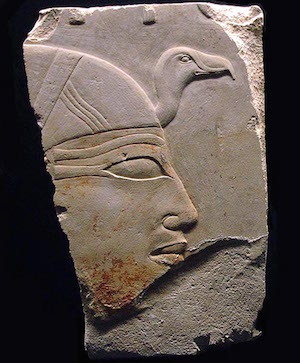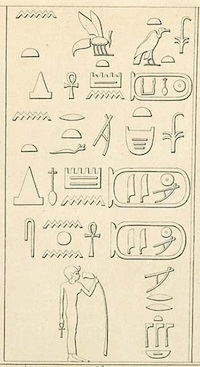
Ankhesenpepi II (also known as Ankhenespepi, Ankhenesmeryre, Ankhenesmerire and Ankhesenpepi) lived towards the end of the sixth dynasty of the Old Kingdom. She was the wife of two pharaohs (Pepi I and Merenre I), the mother of another pharaoh (Pepi II), and probably ruled Egypt as regent while Pepi II was still a child.
She was not of royal blood, but her family was very influential. Her father, Khui, was a prominent official and her mother, Nebet, was the first known female Vizier (although some suggest this was purely an honorific title granted to her when her daughter became the wife of the king). Her brother, Djau, would also serve as Vizier and her sister (confusingly also named Ankhesenpepi/Ankhesenmeryre) was also married to her husband Pepi I.

Her name means “Pepi lives for her”. When she married Pepi I (whose throne name was Meryre) her name changed to Ankhesenmeryre (“Meryre lives for her”). She was initially a traditional sixth dynasty queen with the usual titles (below). When her husband died, she married his successor Merenre I Nemtysaf (the son of her sister and her husband). It was initially thought that her son Pepi II was the son of Pepi I, but it now looks likely that he was actually the son of Merenre. When Merenre died (after a reign of around ten years) Pepi II became king. Many experts now believe that Ankhnespepi acted as regent for the early part of his reign, partly because he was so young. There are a few pieces of art which would seem to support this assumption.

Ankhnespepi II and Pepi II are depicted together in a beautiful alabaster statue (now at the Brooklyn Museum). The statue is clearly making a connection between the queen and Isis, and the young king and Horus. It is also notable that it marks one of the very few occasions that a king is depicted as being smaller than another mortal. It could be considered a visual record of her regency. In the Sinai, she was depicted the same size as her son in a rock cut inscription.
There is also an interesting inscription from Wadi Maghara. The queen (in this instance named Ankhenesmeryre) holds the title “mother of the king”, but it is written in an unconventional way which places the vulture (mwt –mother) inside the word for king (nsw bity), which perhaps again hints at her powerful role. An image of the queen appears at the foot of the inscription. This could simply be considered the determinative for her name (which appears above the figure), but it is worthy of note that there is no corresponding image of the king – perhaps confirming that the expedition was ordered by her and not him. Finally, the burial chamber of her pyramid (which was the largest queens pyramid in Saqqara) is covered in pyramid texts – an honour previously restricted to the pharaoh (although also granted to a few of Pepi II’s wives). After her death her statue was worshipped at Abydos for some time.
Titles
- weret hetes – “Great one of the hetes-sceptre”
- maat heru setesh – “She who sees Horus and Seth”
- weret hest – “Great of Praises”
- hemet-nesu meryetef – “King’s Wife, his beloved
- mut nesu – King’s mother
- hemet-nesu men nefer meryetef – “King’s Wife of Mennefer-Meryre (the pyramid of Meryre)
- mut nesut bity menankh nefer ka re – Mother of the Dual King Men-ankh-Neferkare
- mut nesut menankh nefer ka re – Mother of the king Men-ankh-Neferkare
- sat netjer – Daughter of the god
- sat netjer weret – Daughter of the great god khet wer – possession of the great one tjist heru – Companion of Horus
Bibliography
- Capel, Anne K and Markoe Glenn E. (Editors) (1996) Mistress of the House, Misteress of Heaven
- Dodson, Aidan and Hilton, Dyan (2004) The Complete Royal Families of Ancient Egypt
- Graves-Brown, Carolyn (2010) Dancing for Hathor
- Hawass, Zahi (1995) Silent Images: Women in ancient Egypt
- Robins, Gae (1993) Women in Ancient Egypt
- Tyldesley, Joyce (2006) Chronicle of the Queens of Egypt
- Troy, Lana (1986) Patterns of Queenship in ancient Egyp[tian myth and history
- Verner, Miroslav (2001) The Pyramids
- Ziegler, Christine (Editor) (2008) Queens of Egypt: From Hetepheres to Cleopatra
Copyright J Hill 2018